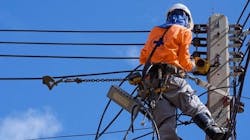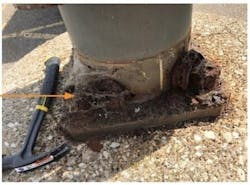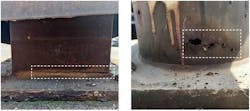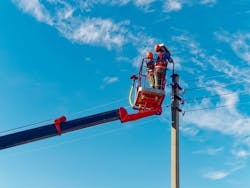Steel Distribution Pole Maintenance: A Complete Guide
The electric power distribution system in the U.S. has over 55 million miles of power lines with over 180 million utility poles. Utility poles line our streetways, and highways and carry power to suburban and rural customers across the country. These poles often share space with other utilities and telecommunication so paying attention to the maintenance of the poles and anchoring systems that support them is critical.
It’s important to understand the condition of your electric power distribution system pole inventory. You must become familiar with their basic components and look for conditions that might warn you of conditions that can become hazardous. Regular utility pole maintenance and inspection should be performed.
Here are some tips for tips for steel distribution pole inspection and maintenance:
Ensure The Foundation’s Safety
Many utility pole foundations are made of reinforced concrete piers with jutting steel anchor bolts. Anchor bolts and washers are used to secure the pole to its foundation. Typical problems with concrete foundations include spalls (fragmenting), cracks, and leaning foundations.
When cracks line up with an embedded anchor bolt, the structural capacity of the assembly could be compromised. For example, the ability to resist wind loads could be reduced, potentially causing the pole to collapse.
Foundation Security: Base Plates
Visually assess the base plate for nut tightness, appropriate hole size, and bearing. A base plate acts as the main contact point between the light pole and the foundation. It’s designed to transfer forces into the anchor bolts and foundation. Base plates help to prevent wind from tipping over the pole assembly. They do this by pulling up on one or more nutted anchor bolts. A pull-through failure might occur if the holes in the base plate are oversized compared to the anchor bolt and nut. That would destabilize the whole structure. Washers might be used as part of the design or to accommodate oversized holes. However, the washers require the proper design to effectively transfer loads without deforming them.
Avoid Covers That Accumulate Moisture
Distribution steel pole structures are usually anchored to their concrete foundation with anchor bolts which are threaded steel rods. They are embedded during foundation concrete placement. The anchor bolts extend above the foundation surface, are aligned with holes in the pole base plate, and are secured with nuts.
Accumulating moisture can speed up corrosion of the base plate, pole, and anchoring components. This ultimately leads to early failure. Base plate and anchor bolt covers can hold moisture and debris which can cause corrosion of the base plate, the anchor bolts, and the pole itself. It is recommended that these covers are not used.
Corrosion on Steel and Ductal Iron Pole Shaft
Water and debris can accumulate inside a steel or ductile iron pole at its base, often entering through open spaces. This can occur below the base plate, through the hand hole in the pole, or other openings. It can cause (or increase) corrosion on the interior surface of the pole. Even when severe, interior corrosion may be visually undetectable from the exterior.
You should visually inspect the exterior pole shaft for areas of corrosion, rust, and any dents or signs that the structural integrity has been compromised. To help determine if there has been any corrosion in the interior of the pole, ultrasonic thickness gauges can be used from the exterior to measure the remaining pole wall thickness.
The easiest way to reduce interior corrosion is to keep the pole interior clean and promote ventilation/drying. This will extend the service life of the pole. You should also regularly apply corrosion-inhibiting coatings on the exterior surfaces of steel poles and base plates.
Each year in North America 2 to 4 million end-of-life poles are replaced. Many are galvanized steel poles, coated with a layer of zinc, a corrosion protection element that prevents the steel from rusting.
Check for Cracks In Brackets and Arms
When crews check cross arms, insulators, conductors, and pole mount transformers, check for cracks in the brackets and braces. These are signs of metal fatigue, that could caused by corrosion, vibration, constant stress, or temperature change.
Preventing Weld Cracks: Pole-to-base Welds
The connection of a steel pole to the base plate typically has a socket-type connection. This occurs where the pole is nested within a hole in the base plate, and the welds around the pole edge at both the top and bottom of the base plate transfer loads from the pole and luminaire to the base plate. Weld cracks are usually the result of cyclical wind loading of light poles. Periodic inspections of welds should be performed by qualified personnel. Square poles, especially those greater than 30 feet in height, are the most susceptible to weld cracking. Square poles experience stress concentrations at the corners, compared to round poles, which allow for a more even distribution of stress on the pole.
Bolt Attachments Installation
Make sure that each anchor and bracket bolt nut is in place and firmly tightened. Tight installation of the upper nuts is critical for long-term performance. If nuts are not properly tightened initially, or if they loosen over time, the subsequent gap will permit the pole or cross arm to rock on its foundation under wind loading. This type of repetitive rocking can cause impact loads on all components. This rocking can increase the risk of developing cracks.
Look For Signs of Pole Vibration
This includes humming or noise in the pole, visible movement of the pole, fixtures on the pole, loose attachments and racks, and rust just above the weld at the base of the pole.
Other Appendages
“Joint Use” in the utility sector refers to multiple utility companies using the same utility poles. Pole attachments are becoming more common, as distribution networks share poles with fiber optics lines, 5G antenna boxes, and other smart devices. These appendages can unintentionally increase the wind and weight loads on the pole. Care should be taken to verify the load capacity of joint-use utility poles.
In recent years, there has been a surge to replace traditional high-intensity discharge (HID) and fluorescent lighting on poles with more cost-effective light-emitting diode (LED) lighting. However, installing LED lighting requires more than a replacement bulb or fixture upgrade. Again, care should be taken to verify the structural and load capacity.
Maximize Safety and Prevent Failures
Electric power distribution poles are among the most common structural systems in the world. The author’s hope is better understanding the basic principles of steel pole construction and implementing routine inspections, will aid qualified personnel in the early identification of defects. When addressed properly, this can prolong service life and prevent failures.
About the Author Neil Peterson is Chief Lighting Specialist at LED Lighting Supply, Peterson has been active in the LED industry for over 10 years and is responsible for product planning and management as well as revenue and operations at LED Lighting Supply. Much of Neil’s time is focused on customer engagement for large commercial and industrial lighting requirements. When not working, Peterson enjoys family time, camping, fishing, and sports.
About the Author
Neil Peterson
Neil Peterson is Chief Lighting Specialist at LED Lighting Supply, Peterson has been active in the LED industry for over 10 years and is responsible for product planning and management as well as revenue and operations at LED Lighting Supply. Much of Neil’s time is focused on customer engagement for large commercial and industrial lighting requirements. When not working, Peterson enjoys family time, camping, fishing, and sports.






